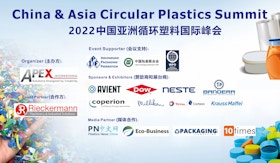
The upcoming China & Asia Flexible Packaging Summit & China & Asia Circular Plastics Summit 2022, will gather over 500 industry professionals and decision makers coming from all across the packaging and plastics value chain. Including brand owners or end users, discussing latest and forthcoming development from perspectives of chemical/petrochemical, machinery, supply chain, technology innovation, R&D and recycling, etc., providing the opportunity to share and examine the emerging new technologies, developments and expanding markets in China and the Asia Pacific region.
Despite the foreseeable Covid-19 Impacts, the global flexible packaging market is forecasted to accelerate at a CAGR of almost 6 per cent through 2020-2024, market growth drivers include but are not limited to longer shelf Life & Changing Lifestyle, processed food & retail Industry expansion and demand for lightweight products, market restraints also exist such as rising raw material cost ,recycling challenges in flexible packaging and competitive marketplace.
Increasing replacement of rigid containers with flexible packaging, together with the growing applications of converted flexible packaging in end-use sectors, including food & beverage, snacks, baked products, health & beauty and pharmaceuticals, are helping polish up the market’s prospects. Flex packs featuring environmental friendly features, convenience, and superior barrier protection properties are expected to witness the highest market gains.
Technical advances have also dramatically changed how flexible packaging is viewed. It’s no longer just a low-cost or expedient option for industrial goods and produce, flexible packaging has gained more popularity across a wide variety of consumer products, increasingly replacing metal cans, glass and rigid plastic bottles, and cartons. Product differentiation, technical development and innovation will continue to reign as key growth drivers for the industry. In addition, new application breakthroughs in the healthcare and pharmaceutical industries are providing ample growth opportunities for flexible packaging raw materials suppliers, chemicals and converters.
Packaging design provides the opportunity to maximize consumer appeal and ease of use, but it must incorporate a degree of price awareness, because many markets function with economics as a primary driving force. Sustainable flexible packaging is the ultimate goal closely associated with the whole flexible packaging value chain, including, packaging brand owners, flexible packaging manufacturers & converters, raw materials & check suppliers, etc. Product safety is a top priority particularly for food and pharmaceutical products, which is receiving increasing attention worldwide.
The circular economy represents an alternative, more sustainable model to the traditional linear economy, which will further enhance industry competitiveness and resource efficiency. The unique characteristics of plastics enable them to play a major role on the road to a more sustainable and resource efficient future. Lightweight, versatile and durable plastics can help save key resources such as energy and water in strategic sectors that include packaging, building and construction, automotive and renewable energy, to name but a few. In addition, plastics applications in packaging can help reduce food waste.
However, to improve the circularity of plastics, it is essential to make sure that more and more plastic waste is recovered and doesn’t end up in landfill or in the environment. The challenge of curbing plastic waste dates to the dawn of the modern environmental movement. More recently, concerns over plastic litter, particularly in marine environments, has reached feverish pitch among consumers, governments and companies themselves. Addressing the waste challenge requires engaging the entire plastics value chain, from polymer manufacturers to brands to waste haulers, in order to create truly systemic solutions.
According to the reliable industry market research data, only 14 per cent of plastics are recycled, resulting in a loss of as much as $120 billion a year to the global economy. In recent months, some of the world biggest brands and plastics manufacturers have issued bold challenges to create new supply chains from plastic waste. It’s a critical start, but success will require broad, global engagement among companies, governments, policy makers and others to create a truly circular plastics economy.
Sponsor/exhibitor contact
James Chen
[javascript protected email address]
Publish your content with EB Publishing
It's about who you reach. Get your news, events, jobs and thought leadership seen by those who matter to you.











